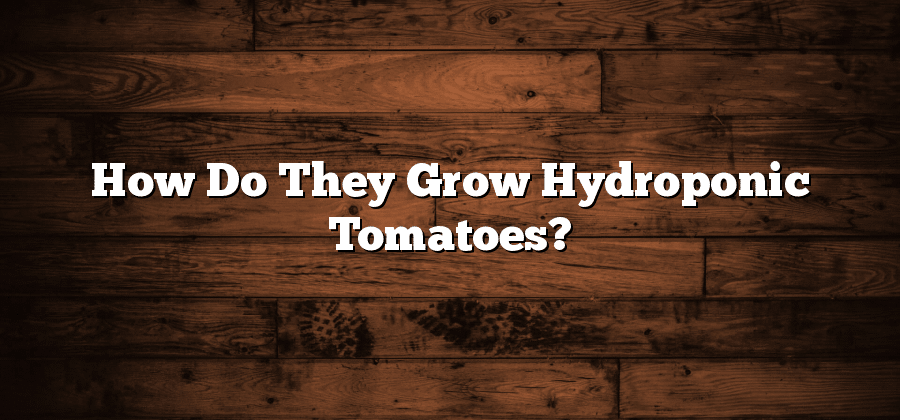Selecting the Ideal Tomato Varieties for Hydroponic Cultivation
When it comes to selecting the ideal tomato varieties for hydroponic cultivation, there are several factors to consider. The first factor is the growth habit of the tomato plant. Determinate varieties, which grow to a specific height and then stop, are typically better suited for hydroponic systems with limited vertical space. On the other hand, indeterminate varieties continue to grow and produce fruit throughout the growing season, requiring more vertical support.
Another important factor to consider is the fruit characteristics of the tomato varieties. Some varieties are known for their size, producing large beefsteak tomatoes, while others are known for their quantity, producing clusters of smaller-sized cherry tomatoes. It is important to determine the market demand and consumer preferences when selecting the tomato varieties for hydroponic cultivation.
Furthermore, disease resistance is a critical consideration. Tomato plants in hydroponic systems can be more susceptible to certain diseases and pests due to the controlled environment. Selecting tomato varieties that are resistant to common diseases such as powdery mildew, blight, and root rot can help minimize the risk of crop loss and ensure a successful harvest.
Preparing the Hydroponic Growing Medium
Hydroponic cultivation of tomatoes requires a carefully prepared and well-balanced growing medium. The choice of growing medium is crucial for the success of the hydroponic system as it serves as a support for the plants and provides the necessary aeration and drainage. When selecting a growing medium for tomatoes, it is important to consider factors such as water retention capacity, pH neutrality, and nutrient-holding capability.
One of the most commonly used growing mediums for hydroponic tomatoes is coconut coir. Coconut coir is a sustainable and renewable option that offers excellent water retention properties, ensuring consistent hydration for the plants. Additionally, it provides a stable and secure environment for the roots to anchor and grow. Another popular choice for growing medium is perlite, a lightweight volcanic mineral that provides good aeration and drainage. Its porous nature allows for optimal oxygenation of the roots, promoting healthy growth.
Providing the Essential Nutrient Solution for Tomatoes
Tomatoes are known to be heavy feeders, requiring a balanced and nutrient-rich solution to thrive in a hydroponic system. The essential nutrient solution provides the necessary elements for healthy plant growth and high yields. When it comes to selecting the ideal nutrient solution for tomatoes, there are a few key considerations to keep in mind.
First and foremost, it is crucial to choose a nutrient solution specifically formulated for tomatoes or other fruiting crops. These solutions are typically rich in macronutrients such as nitrogen (N), phosphorus (P), and potassium (K), as well as essential micronutrients like calcium (Ca), magnesium (Mg), and iron (Fe). The precise ratios and concentrations of these elements may vary depending on the specific brand and product. It is essential to carefully read and follow the instructions provided by the manufacturer to ensure the proper nutrient balance for optimal plant growth. Additionally, it is recommended to use a pH meter to monitor and adjust the acidity level of the nutrient solution, as tomatoes prefer a slightly acidic pH range of 5.8 to 6.3 for optimal nutrient uptake and overall health.
Establishing the Optimal Environmental Conditions
Temperature and humidity are crucial factors to consider when establishing the optimal environmental conditions for hydroponic tomato cultivation. Tomatoes prefer temperatures ranging from 70 to 80 degrees Fahrenheit during the day and slightly cooler temperatures, around 60 to 70 degrees Fahrenheit, at night. Maintaining a consistent temperature within this range is important to promote healthy growth and development of the plants. In addition, maintaining an ideal humidity level is vital for preventing diseases and ensuring proper pollination. The recommended relative humidity for tomato plants in hydroponic systems is between 70% to 80%.
Additionally, adequate ventilation is essential for establishing the optimal environmental conditions for hydroponic tomato cultivation. Proper air circulation helps regulate temperature, humidity, and carbon dioxide levels within the growing area. This can be achieved by using fans or natural ventilation methods such as strategically placed vents. Ensuring sufficient airflow not only prevents the buildup of excess moisture, which can lead to fungal diseases, but also provides the tomato plants with the carbon dioxide they need for photosynthesis. By maintaining the ideal temperature, humidity, and ventilation, growers can create an environment that promotes vigorous growth and improves overall tomato yield in hydroponic systems.






